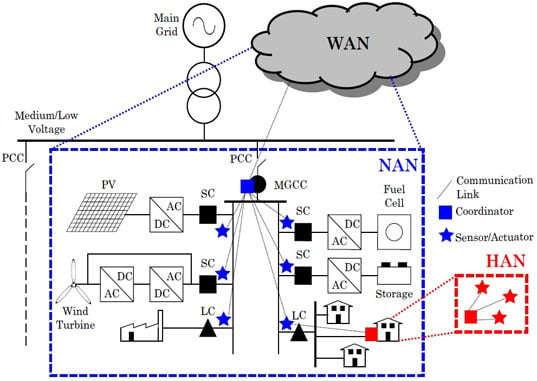Application of Wireless Sensor and Actuator Networks to Achieve Intelligent Microgrids: A Promising Approach towards a Global Smart Grid Deployment
Abstract
:1. Introduction
2. Principles of Electrical Microgrid Management
2.1. Hierarchical Management
- Grid level: This is the outer level of the hierarchical management architecture. The main elements are the distribution network operator (DNO) and the market operator (MO). Their main roles are, respectively, to communicate with different microgrid central controllers (MGCCs), and to manage the MG when it operates on the market (connected to the grid).
- Management level: This stage is controlled by the MGCC, which ensures the synchronization between the MG and the main grid or the quality of the voltage and frequency of the MG, among other functions.
- Field level: The inner level of the management scheme is devoted to control the MG at the loads and sources level (balance between generation and consumption, islanding detection, power balance, etc.).
2.2. Centralized vs. Decentralized Management
2.3. Demand Side Management
3. Management of Electrical Grids by Means of WSANs
3.1. Main Characteristics of a WSAN
- Hardware constraints: The size of nodes, as well as their weight, must be as small as possible.
- Power consumption: This is one of the main constraints for a sensor/actuator node. Batteries are the principal power source for nodes, along with (but not necessarily) energy harvesting solutions. Therefore, the power consumption must be dramatically minimized.
- Fault tolerance: The correct operation of a WSAN must not be disturbed by the failure of one or more sensors.
- Scalability: It is necessary to develop management techniques to deal with networks containing up to hundreds or thousands of nodes (each node supporting a sensor and/or an actuator). The scalability is directly linked with the network topology.
- Transmission media: Communication among nodes is implemented by means of wireless technologies, and messages are broadcasted directly to the medium. Thus, security and privacy mechanisms must be implemented.
- Operation environment: Sensor/actuator nodes must be able to work in harsh environments, in terms of extreme temperatures, high humidity levels, electromagnetic interferences, vibrations, etc.
3.2. Application of WSANs to Manage the Whole Electrical Grid
3.2.1. WSANs for Power Generation Management
3.2.2. WSANs for Energy Transmission and Distribution Networks Management
3.2.3. WSANs Applied to End Users Management
3.3. Synthesis
4. Communication Technologies for WSANs Applied to the SG
4.1. The Origins of Communication Technologies in Electrical Grids
4.2. From Home Area Network to Wide Area Network
- Home Area Network (HAN), dedicated to connect different kinds of devices in the home such as displays, computers and electricity or gas meters. Home automation applications are also placed at the HAN level. In the context of SGs, HANs represent the lowest level of the overall infrastructure and permit, for example, to connect smart meters and control devices for distributed renewable sources and Plug-in Hybrid Electric Vehicles, and to implement DR applications. The coverage range of a HAN is usually limited to ten meters.
- Neighborhood Area Network (NAN), which plays the role of gateway between HANs and the upper level. Very frequently, NANs transmit the data information between customer locations, issued from different HANs, and data aggregation points. Therefore, NAN must guarantee a range of around thousands of meters. Besides, the coverage of a NAN is particularly well adapted to the dimensions of medium-size electrical MGs; that is, a MG comprising some buildings (techno poles, residential areas or little villages) or installed in large buildings such as hospitals.
- Wide Area Network (WAN), which constitutes the backbone of SG communication network. The main task of a WAN is to transfer the overall collected data to grid operators, and command messages to the consumers. Thus, WAN must be able to carry large amount of data on wide range. Nowadays, the Internet is the most important WAN, allowing the transmission of high data volumes worldwide.
4.2.1. Home Area Networks and Neighborhood Area Networks
- Bluetooth: This low power consumption wireless communication protocol, whose physical layer is defined by the IEEE 802.15.1 standard, was designed to be applied in personal area networks (PANs). Bluetooth has a short-range coverage of 10 m that can be enlarged to 100 m by means of repeaters, offering a data rate of about 720 kbps. In HANs, Bluetooth and their low-energy version (Bluetooth LE [72,73]) are interesting solutions to interface smart meters and customer devices.
- ZigBee: Based on the IEEE 802.15.4 standard and adapted to mesh networking and low duty-cycle applications, ZigBee proposes a data rate of 250 kbps for a coverage range of 100 m without repeaters. It is able to transmit data employing different ISM frequency bands such as 868 MHz, 915 MHz and 2.4 GHz. Nowadays, ZigBee is considered one of the most suitable technologies for networking devices in HANs. Consequently, it is frequently used as communication protocol for WSANs applications, such as consumer appliances control, distribution system monitoring or smart power monitoring.
- Wireless Fidelity (WiFi): Nowadays, WiFi is the wireless technology most commonly deployed in homes and buildings, and their characteristics make WiFi an attractive communication protocol for NANs. Based on the IEEE 802.11 standard, this low cost solution offers a high data rate, up to few Gbps, along with a coverage range of about 200 m. However, the high power consumption is the main drawback for WiFi to be used as communication protocol in WSANs.
- Other solutions that can be applied at HAN and NAN levels are the ultra-low-power emerging wireless communication technologies adapted to M2M applications and particularly, to WSANs [74]. These wireless technologies, proposed for instance by Wavenis, LoRa or SIGFOX, present a long-range coverage, from 200 m to few tens of kilometers, with low data rates (up to 100 kbps) [75].
4.2.2. Wide Area Network
- Ethernet, which guarantees high data rates, up to 100 Gbps, ensures the data transport up to 10 kilometers using optical fiber without repeaters.
- WiMAX: Based on IEEE 802.16 standard, Worldwide Interoperability Microwave Access ensures a high data rate access, between 11 Mbps and 108 Mbps, to the Internet network with a coverage distance of several kilometers.
- Cellular technologies: Technologies currently used for mobile phone communications could also be another possibility to manage intelligent electrical grids by means of their capability of data transmission. In this case, Global System for Mobile Communication (GSM) offers the lowest data rate, around 9.6 kbps, whereas the higher data rate transmissions are reached by Universal Mobile Telecommunication System (UMTS) and High-Speed Downlink Packet Access (HSDPA), which offers 2 Mbps and 14 Mbps, respectively [80,81]. These solutions, which are widespread over the world, also provide wide range coverage, up to few kilometers. The 4th generation (4G), based on LTE, reaches data rates up to 100 Mbps [82,83].
- IEEE 802.22: Due to the lack of frequency resources, this standard constitutes an alternative solution to ensure long-range wireless communication by using white spaces in the overall frequency spectrum such as television band (TVWS). This solution offers a range of 10 to 100 km and data rates of few Mbps, needs the cognitive radio (CR) [84] technology in order to detect unused frequency and to transmit data.
4.3. Synthesis
5. The Evolution towards a Global Smart Grid Deployment: Challenges and Perspectives
5.1. Data Communication and WSANs
5.1.1. Harsh Environmental Operation Scenario
5.1.2. Quality of Service
5.1.3. Security
- Privacy, a critical issue that is very frequently attacked. Privacy must be assured not only for related customer information, but also for the commercial transactions related with the operation of the whole electrical grid. Some privacy protection mechanisms are based on standard schemes. In example, EG2 (one recommendation proposed by the Expert Groups of the European Commission) recommends a technique that separates the smart metering data into low-frequency attributable data (data used for billing) and high-frequency anonymous technical data (data used for demand side management) [69].
- Integrity, whose aim is to avoid illegal modifications of the transmitted data. Authentication mechanisms [94] are traditional solutions in order to ensure a correct identification of the transmitter and the receiver of the message, allowing the detection of possible data corruption.
- Availability, that is, the possibility for authorized users to get access to the network services even if an attack has occurred. Communication among nodes and a central access control system can be an appropriate solution in order to ensure the availability of the network.
5.1.4. Resource Constraints
5.2. Evolution and Adaptability of MGs towards a SG Scenario
5.2.1. New End Users and Equipment Connected to the Grid
5.2.2. Towards a Multi-Generation Scenario
6. Conclusions
Author Contributions
Conflicts of Interest
References
- Ruiz-Romero, S.; Colmenar-Santos, A.; Mur-Pérez, F.; López-Rey, A. Integration of distributed generation in the power distribution network: The need for smart grid control systems, communication and equipment for a smart city—Use cases. Renew. Sustain. Energy Rev. 2014, 38, 223–234. [Google Scholar] [CrossRef]
- Niyato, D.; Wang, P. Cooperative transmission for meter data collection in smart grid. IEEE Commun. Mag. 2012, 50, 90–97. [Google Scholar] [CrossRef]
- Arnold, G.W. Smart Grid. In Green IT: Technologies and Applications; Kim, J.H., Lee, M.J., Eds.; Springer: Berlin, Germany, 2011; Chapter 17. [Google Scholar]
- Asmus, P. Microgrids, Virtual power plants and our distributed energy future. Electr. J. 2010, 23, 72–82. [Google Scholar] [CrossRef]
- Kroposki, B.; Lasseter, R.; Ise, T.; Morozumi, S.; Papathanassiou, S.; Hatziargyriou, N. Making microgrids work. IEEE Power Energy Mag. 2008, 6, 40–53. [Google Scholar] [CrossRef]
- Katiraei, F.; Iravani, R.; Hatziargyriou, N.; Dimeas, A. Microgrids management. IEEE Power Energy Mag. 2008, 6, 54–65. [Google Scholar] [CrossRef]
- Awad, B.; Wu, J.; Jenkins, N. Control of distributed generation. Elektrotech. Informationstech. 2008, 125, 409–414. [Google Scholar] [CrossRef]
- Vasquez, J.; Guerrero, J.; Miret, J.; Castilla, M.; de Vicuña, L. Hierarchical control of intelligent microgrids. IEEE Ind. Electron. Mag. 2010, 4, 23–29. [Google Scholar] [CrossRef]
- Mohamed, Y.; Radwan, A. Hierarchical control system for robust microgrid operation and seamless mode transfer in active distribution systems. IEEE Trans. Smart Grid 2011, 2, 352–362. [Google Scholar] [CrossRef]
- Llaria, A.; Curea, O.; Jiménez, J.; Camblong, H. Survey on microgrids: Unplanned islanding and related inverter control techniques. Renew. Energy 2011, 36, 2052–2061. [Google Scholar] [CrossRef]
- Planas, E.; Gil-de-Muro, A.; Andreu, J.; Kortabarria, I.; Martínez de Alegría, I. General aspects, hierarchical controls and droop methods in microgrids: A review. Renew. Sustain. Energy Rev. 2013, 17, 147–159. [Google Scholar] [CrossRef]
- Dimeas, A.; Hatziargyriou, N. Operation of a multiagent system for microgrid control. IEEE Trans. Power Syst. 2005, 20, 1447–1455. [Google Scholar] [CrossRef]
- Logenthiran, T.; Srinivasan, D.; Khambadkone, A.M. Multi-agent system for energy resource scheduling of integrated microgrids in a distributed system. Electr. Power Syst. Res. 2011, 81, 138–148. [Google Scholar] [CrossRef]
- Jiayi, H.; Chuanwen, J.; Rong, X. A review on distributed energy resources and microgrid. Renew. Sustain. Energy Rev. 2008, 12, 2465–2476. [Google Scholar] [CrossRef]
- Liang, H.; Choi, B.J.; Zhuang, W.; Shen, X.; Awad, A.; Abdr, A. Multiagent coordination in microgrids via wireless networks. IEEE Wirel. Commun. 2012, 19, 14–22. [Google Scholar] [CrossRef]
- Palensky, P.; Dietrich, D. Demand Side Management: Demand response, intelligent energy systems, and smart loads. IEEE Trans. Ind. Inform. 2011, 7, 381–388. [Google Scholar] [CrossRef]
- Gellings, C.W.; Samotyj, M. Smart Grid as advanced technology enabler of demand response. Energy Effic. 2013, 6, 685–694. [Google Scholar] [CrossRef]
- Costanzo, G.T.; Zhu, G.; Anjos, M.F.; Savard, G. A system architecture for autonomous demand side load management in smart buildings. IEEE Trans. Smart Grid 2012, 3, 2157–2165. [Google Scholar] [CrossRef]
- Atzeni, I.; Ordóñez, L.G.; Scutari, G.; Palomar, D.P.; Fonollosa, J.R. Demand-side management via distributed energy generation and storage optimization. IEEE Trans. Smart Grid 2013, 4, 866–876. [Google Scholar] [CrossRef]
- Ma, J.; Deng, J.; Song, L.; Han, Z. Incentive mechanism for demand side management in smart grid using auction. IEEE Trans. Smart Grid 2014, 5, 1379–1388. [Google Scholar] [CrossRef]
- Akyildiz, I.F.; Su, W.; Sankarasubramaniam, Y.; Cayirci, E. A survey on sensor networks. IEEE Commun. Mag. 2002, 40, 102–114. [Google Scholar] [CrossRef]
- Yick, J.; Mukherjee, B.; Ghosal, D. Wireless sensor network survey. Comput. Netw. 2008, 52, 2292–2330. [Google Scholar] [CrossRef]
- Horneber, J.; Hergenroder, A. A Survey on testbeds and experimentation environments for wireless sensor networks. IEEE Commun. Surv. Tutor. 2014, 16, 1820–1838. [Google Scholar] [CrossRef]
- Matta, N.; Rahim-Amoud, R.; Merghem-Boulahia, L.; Jrad, A. Enhancing smart grid operation by using a WSAN for substation monitoring and control. In Proceedings of the IFIP Wireless Days (WD), Dublin, Ireland, 21–23 November 2012.
- Molina-Garcia, A.; Fuentes, J.A.; Gomez-Lazaro, E.; Bonastre, A.; Campelo, J.C.; Serrano, J.J. Development and assessment of a wireless sensor and actuator network for heating and cooling loads. IEEE Trans. Smart Grid 2012, 3, 1192–1202. [Google Scholar] [CrossRef]
- Grilo, A.M.; Chen, J.; Diaz, M.; Garrido, D.; Casaca, A. An integrated WSAN and SCADA system for monitoring a critical infrastructure. IEEE Trans. Ind. Inform. 2014, 10, 1755–1764. [Google Scholar] [CrossRef]
- Gungor, V.C.; Lu, B.; Hancke, G.P. Opportunities and challenges of wireless sensor Networks in smart grid. IEEE Trans. Ind. Electron. 2010, 57, 3557–3564. [Google Scholar] [CrossRef]
- Liu, Y. Wireless Sensor Network applications in smart grid: Recent trends and challenges. Int. J. Distrib. Sens. Netw. 2012, 2012. [Google Scholar] [CrossRef]
- Ozan-Bicen, A.; Akan, O.B.; Gungor, V.C. Spectrum aware and cognitive sensor networks for smart grid applications. IEEE Commun. Mag. 2012, 50, 158–165. [Google Scholar] [CrossRef]
- Erol-Kantarci, M.; Mouftah, H.T. Demand management and Wireless Sensor Networks in the smart grid. In Energy Management Systems; Giridhar-Kini, P., Ed.; InTech: Rijeka, Croatia, 2011. [Google Scholar]
- Ma, L.; Li, B.; Yang, Z.B.; Du, J.; Wang, J. A new combination prediction model for short-term wind farm output power based on meteorological data collected by WSN. Int. J. Control Autom. 2014, 7, 171–180. [Google Scholar] [CrossRef]
- Achleitner, S.; Kamthe, A.; Liu, T.; Cerpa, A.E. SIPs: Solar irradiance prediction system. In Proceedings of the 13th International Symposium on Information Processing in Sensor Networks (ISPN), Berlin, Germany, 15–17 April 2014; pp. 225–236.
- Al-Anbagi, I.; Mouftah, H.; Erol-Kantarci, M. Design of a delay-sensitive WSN for wind generation monitoring in the smart grid. In Proceedings of the IEEE 24th Canadian Conference on Electrical and Computer Engineering (CCECE), Niagara Falls, ON, Canada, 8–11 May 2011.
- Llaria, A.; Curea, O.; Jiménez, J.; Martin, J.L.; Zuloaga, A. Wireless communication system for microgrids management in islanding. In Proceedings of the 14th European Conference on Power Electronics and Applications (EPE), Birmingham, UK, 30 August–1 September 2011.
- Ruizhong, L.; Wang, Z.; Sun, Y. Wireless sensor networks solutions for real time monitoring of nuclear power plant. In Proceedings of the Fifth World Congress on Intelligent Control and Automation (WCICA), Hangzhou, China, 15–19 June 2004; pp. 3663–3667.
- Hammons, T.J.; Lescale, V.F.; Uecker, K.; Haeusler, M.; Retzmann, D.; Staschus, K.; Lepy, S. State of the art in Ultrahigh-Voltage transmission. Proc. IEEE 2012, 100, 360–390. [Google Scholar] [CrossRef]
- Okba, M.H.; Saiect, M.H.; Mostafa, M.Z.; Abdel-Moneim, T.M. High voltage direct current transmission—A review, Part I. In Proceedings of the IEEE Energytech, Cleveland, OH, USA, 29–31 May 2012.
- Yang, Y.; Lambert, F.; Divan, D. A survey on technologies for implementing sensor networks for power delivery systems. In Proceedings of the IEEE Power Engineering Society General Meeting, Tampa, FL, USA, 24–28 June 2007.
- Tuna, G.; Gungor, V.C.; Gulez, K. Wireless sensor networks for smart grid applications: A case study on link reliability and node lifetime evaluations in power distribution systems. Int. J. Distrib. Sens. Netw. 2013, 2013. [Google Scholar] [CrossRef]
- Leon, R.A.; Vittal, V.; Manimaran, G. Application of sensor network for secure electric energy infrastructure. IEEE Trans. Power Deliv. 2007, 22, 1021–1028. [Google Scholar] [CrossRef]
- Fateh, B.; Govindarasu, M.; Ajjarapu, V. Wireless network design for transmission line monitoring in smart grid. IEEE Trans. Smart Grid 2013, 4, 1076–1086. [Google Scholar] [CrossRef]
- Siano, P. Demand response and smart grids—A survey. Renew. Sustain. Energy Rev. 2014, 30, 461–478. [Google Scholar] [CrossRef]
- Kabalci, Y. A survey on smart metering and smart grid communication. Renew. Sustain. Energy Rev. 2016, 57, 302–318. [Google Scholar] [CrossRef]
- Finster, S.; Baumgart, I. Privacy-aware smart metering: A survey. IEEE Commun. Surv. Tutor. 2015, 17, 1088–1101. [Google Scholar] [CrossRef]
- Karimi, B.; Namboodiri, V.; Jadliwala, M. Scalable meter data collection in smart grids through message concatenation. IEEE Trans. Smart Grid 2015, 6, 1697–1706. [Google Scholar] [CrossRef]
- Popovic, Z.; Cackovic, V. Advanced metering infrastructure in the context of smart grids. In Proceedings of the IEEE International Energy Conference (ENERGYCON), Dubrovnik, Croatia, 13–16 May 2014; pp. 1509–1514.
- Sui, H.; Sun, Y.; Lee, W.J. A demand side management model based on advanced metering infrastructure. In Proceedings of the 4th International Conference on Electric Utility Deregulation and Restructuring and Power Technologies (DRPT), Weihai, China, 6–9 July 2011; pp. 1586–1589.
- McLaughlin, S.; Holbert, B.; Fawaz, A.; Berthier, R.; Zonouz, S. A multi-sensor energy theft detection framework for advanced metering infrastructures. IEEE J. Sel. Areas Commun. 2013, 31, 1319–1330. [Google Scholar] [CrossRef]
- Cao, L.; Tian, J.; Liu, Y. Remote wireless automatic meter reading system based on wireless mesh networks and embedded technology. In Proceedings of the Fifth IEEE International Symposium on Embedded Computing (SEC), Beijing, China, 6–8 October 2008; pp. 192–197.
- Tung, H.Y.; Tsang, K.F.; Chui, K.T.; Tung, H.C.; Chi, H.R.; Hancke, G.P.; Man, K.F. The generic design of a high-traffic advanced metering infrastructure using ZigBee. IEEE Trans. Ind. Inform. 2014, 10, 836–844. [Google Scholar] [CrossRef]
- Asad, O.; Erol-Kantarci, M.; Mouftah, H.T. A survey of sensor web services for the smart grid. J. Sens. Actuator Netw. 2013, 2, 98–108. [Google Scholar] [CrossRef]
- Erol-Kantarci, M.; Mouftah, H.T. Wireless sensors networks for cost-efficient residential energy management in the smart grid. IEEE Trans. Smart Grid 2011, 2, 314–325. [Google Scholar] [CrossRef]
- Stamatescu, G.; Stamatescu, I.; Arghira, N.; Fagarasan, I.; Iliescu, S.S. Embedded networked monitoring and control for renewable energy storage systems. In Proceedings of the International Conference on Development and Application Systems (DAS), Suceava, Romania, 15–17 May 2014.
- Ancilloti, E.; Bruno, R.; Conti, M. The role of communication systems in smart grids: Architectures, technical solutions and research challenges. Comput. Commun. 2013, 36, 1665–1697. [Google Scholar] [CrossRef]
- Ma, R.; Chen, H.H.; Huang, Y.R.; Meng, W. Smart grid communication: Its challenges and opportunities. IEEE Trans. Smart Grid 2013, 4, 36–46. [Google Scholar] [CrossRef]
- Wu, F.; Moslehi, K.; Bose, A. Power system control centers: Past, present, and future. Proc. IEEE 2005, 6, 1890–1908. [Google Scholar] [CrossRef]
- Gaushell, D.; Block, W. SCADA communication techniques and standards. IEEE Comput. Appl. Power 1993, 6, 45–50. [Google Scholar] [CrossRef]
- Ghoshal, K. Distribution automation: SCADA integration is key. IEEE Comput. Appl. Power 1997, 10, 31–35. [Google Scholar] [CrossRef]
- McDonald, J. Adaptive intelligent power systems: Active distribution networks. Energy Policy 2008, 36, 4346–4351. [Google Scholar] [CrossRef]
- Bayod-Rujula, A. Future development of the electricity systems with distributed generation. Energy 2009, 34, 377–383. [Google Scholar] [CrossRef]
- Hiremath, R.; Shikha, S.; Ravindranath, N. Decentralized energy planning, modeling and application—A review. Renew. Sustain. Energy Rev. 2007, 11, 729–752. [Google Scholar] [CrossRef]
- Blaabjerg, F.; Teodorescu, R.; Liserre, M.; Timbus, A. Overview of control and grid synchronization for distributed power generation systems. IEEE Trans. Ind. Electron. 2006, 53, 1398–1409. [Google Scholar] [CrossRef]
- Rifkin, J. The third industrial revolution. Eng. Technol. 2008, 3, 26–27. [Google Scholar] [CrossRef]
- Moslehi, K.; Kumar, R. A reliability perspective of the smart grid. IEEE Trans. Smart Grid 2010, 1, 57–64. [Google Scholar] [CrossRef]
- Khalifa, T.; Naik, K.; Nayak, A. A survey of communication protocols for automatic meter reading applications. IEEE Commun. Surv. Tutor. 2011, 13, 168–182. [Google Scholar] [CrossRef]
- Mauri, G.; Mirandola, P. Suitability of AMR systems to provide demand control services for LV and MV electricity customers. In Proceedings of the 18th International Conference and Exhibition on Electricity Distribution (CIRED), Turin, Italy, 6–9 June 2005.
- Hamilton, K.; Gulhar, N. Taking demand response to the next level. IEEE Power Energy Mag. 2010, 8, 60–65. [Google Scholar] [CrossRef]
- Liu, Y.; Fischer, R.A.; Schulz, N.N. Distribution system outage and restoration analysis using a wireless AMR system. In Proceedings of the IEEE Power Engineering Society Winter Meeting, New York, NY, USA, 27–31 January 2002; pp. 871–875.
- Fan, Z.; Kulkarni, P.; Gormus, S.; Efthymiou, C.; Kalogridis, G.; Sooriyabandara, M.; Zhu, Z.; Lambotharan, S.; Chin, W.H. Smart grid communications: Overview of research challenges, solutions, and standardization activities. IEEE Commun. Surv. Tutor. 2013, 15, 21–38. [Google Scholar] [CrossRef]
- Zhu, Z.; Lambotharan, S.; Chin, W.H.; Fan, Z. Overview of demand management in smart grid and enabling wireless communication technologies. IEEE Wirel. Commun. 2012, 19, 48–56. [Google Scholar]
- Gomez, C.; Paradells, J. Wireless home automation networks: A survey of architectures and technologies. IEEE Commun. Mag. 2010, 48, 92–101. [Google Scholar] [CrossRef]
- Want, R.; Schilit, B.; Laskowski, D. Bluetooth LE finds its niche. IEEE Pervasive Comput. 2013, 12, 12–16. [Google Scholar] [CrossRef]
- Nieminen, J.; Gomez, C.; Isomaki, M.; Savolainen, T.; Patil, B.; Shelby, Z.; Xi, M.; Oller, J. Networking solutions for connecting bluetooth low energy enabled machines to the Internet of Things. IEEE Netw. 2014, 28, 83–90. [Google Scholar] [CrossRef]
- Chen, M.; Wan, J.; Gonzalez, S.; Liao, X.; Leung, V.C.M. A survey of recent developments in home M2M networks. IEEE Commun. Surv. Tutor. 2014, 16, 98–114. [Google Scholar] [CrossRef]
- Abdul-Salam, S.; Mahmud, S.A.; Al-Raweshidy, H.S. M2M communication in Smart Grids: Implementation scenarios and performance analysis. In Proceedings of the IEEE Wireless Communications and Networking Conference Worshops (WCNCW), Paris, France, 1 April 2012; pp. 142–147.
- Huang, P.; Xiao, L.; Soltani, S.; Mutka, M.W.; Xi, N. The evolution of MAC protocols in wireless sensor networks: A survey. IEEE Commun. Surv. Tutor. 2013, 15, 101–120. [Google Scholar] [CrossRef]
- Luo, J.; Hu, J.; Wu, D.; Li, R. Opportunistic routing algorithm for relay node selection in Wireless Sensor Networks. IEEE Trans. Ind. Inform. 2015, 11, 112–121. [Google Scholar] [CrossRef]
- Liu, J.; Zhao, B.; Geng, L.; Yuan, Z.; Wang, Y. Communication performance of broadband PLC technologies for smart grid. In Proceedings of the IEEE International Symposium on Power Line Communications and Its Applications (ISPLC), Udine, Italy, 3–6 April 2011; pp. 491–496.
- Sarafi, A.; Tsiropoulos, G.; Cottis, P. Hybrid wireless-broadband over power lines: A promising broadband solution in rural areas. IEEE Commun. Mag. 2009, 47, 140–147. [Google Scholar] [CrossRef]
- Mohr, W.; Konhauser, W. Access network evolution beyond third generation mobile communications. IEEE Commun. Mag. 2000, 38, 122–133. [Google Scholar]
- De Vriendt, J.; Laine, P.; Lerouge, C.; Xu, X. Mobile network evolution: A revolution on the move. IEEE Commun. Mag. 2002, 40, 104–111. [Google Scholar] [CrossRef]
- Roberts, M.L.; Temple, M.A.; Mills, R.F.; Raines, R.A. Evolution of the air interface of cellular communications systems toward 4G realization. IEEE Commun. Surv. Tutor. 2006, 8, 2–23. [Google Scholar] [CrossRef]
- Raychaudhuri, D.; Mandayam, N.B. Frontiers of wireless and mobile communications. Proc. IEEE 2012, 100, 824–840. [Google Scholar] [CrossRef]
- Khan, A.A.; Rehmani, M.H.; Reisslein, M. Cognitive Radio for Smart Grids: Survey of architectures, spectrum sensing mechanisms, and networking protocols. IEEE Commun. Surv. Tutor. 2016, 18, 860–898. [Google Scholar] [CrossRef]
- Galli, S.; Scaglione, A.; Wang, Z. For the grid and through the grid: The role of power line communications in the smart grid. Proc. IEEE 2011, 99, 998–1027. [Google Scholar] [CrossRef]
- Krutina, A.; Bartovský, J. PLC communication in smart grid. In Proceedings of the 15th International Scientific Conference on Electric Power Engineering (EPE), Brno, Czech Republic, 12–14 May 2014; pp. 165–168.
- Degardin, V.; Kilani, K.; Kone, L.; Lienard, M.; Degauque, P. Feasibility of a high-bit-rate power-line communication between an inverter and a motor. IEEE Trans. Ind. Electron. 2014, 61, 4816–4823. [Google Scholar] [CrossRef]
- Mahapatro, A.; Khilar, P.M. Fault diagnosis in wireless sensor networks: A survey. IEEE Commun. Surv. Tutor. 2013, 15, 2000–2026. [Google Scholar] [CrossRef]
- Al-Anbagi, I.; Erol-Kantarci, M.; Mouftah, H.T. Delay critical smart grid applications and adaptive QoS provisioning. IEEE Access 2015, 3, 1367–1378. [Google Scholar] [CrossRef]
- Metke, A.R.; Ekl, R.L. Security technology for smart grid networks. IEEE Trans. Smart Grid 2010, 1, 99–107. [Google Scholar] [CrossRef]
- Erol-Kantarci, M.; Mouftah, H.T. Wireless multimedia sensor and actor networks for the next generation power grid. Ad Hoc Netw. 2011, 9, 542–551. [Google Scholar] [CrossRef]
- Butun, I.; Morgera, S.D.; Sankar, R. A survey of intrusion detection systems in wireless sensor networks. IEEE Commun. Surv. Tutor. 2014, 16, 266–282. [Google Scholar] [CrossRef]
- Raymond, D.R.; Midkiff, S.F. Denial-of-Service in wireless sensor networks: Attacks and defenses. IEEE Pervasive Comput. 2008, 7, 74–81. [Google Scholar] [CrossRef]
- Nicanfar, H.; Jokar, P.; Beznosov, K.; Leung, V.C.M. Efficient authentication and key management mechanisms for smart grid communications. IEEE Syst. J. 2014, 8, 629–640. [Google Scholar] [CrossRef]
- He, D.; Chan, S.; Zhang, Y.; Guizani, M.; Chen, C.; Bu, J. An enhanced public key infrastructure to secure smart grid wireless communication networks. IEEE Netw. 2014, 28, 10–16. [Google Scholar] [CrossRef]
- Zhou, Y.; Fang, Y.; Zhang, Y. Securing wireless sensor networks: A survey. IEEE Commun. Surv. Tutor. 2008, 10, 6–28. [Google Scholar] [CrossRef]
- Wang, Y.; Attebury, G.; Ramamurthy, B. A survey of security issues in wireless sensor networks. IEEE Commun. Surv. Tutor. 2006, 8, 2–23. [Google Scholar] [CrossRef]
- Gungor, V.C.; Lambert, F.C. A survey on communication networks for electric system automation. Comput. Netw. 2006, 50, 877–897. [Google Scholar] [CrossRef]
- Farooq, M.O.; Kunz, T. Operating systems for wireless sensor networks: A survey. Sensors 2011, 11, 5900–5930. [Google Scholar] [CrossRef] [PubMed]
- Baccelli, E.; Hahm, O.; Günes, M.; Wählisch, M.; Schmidt, T.C. RIOT OS: Towards an OS for the internet of things. In Proceedings of the IEEE Computer Communications Workshops (INFOCOM), Turin, Italy, 14–19 April 2013; pp. 79–80.
- Al-Karaki, J.N.; Kamal, A.E. Routing techniques in wireless sensor networks: A survey. IEEE Wirel. Commun. 2004, 11, 6–28. [Google Scholar] [CrossRef]
- Aziz, A.A.; Sekercioglu, Y.A.; Fitzpatrick, P.; Ivanovich, M. A survey on distributed topology control techniques for extending the lifetime of battery powered Wireless Sensor Networks. IEEE Commun. Surv. Tutor. 2013, 15, 121–144. [Google Scholar] [CrossRef]
- Prasad, R.V.; Devasenapathy, S.; Rao, V.S.; Vazifehdan, J. Reincarnation in the ambiance: Devices and networks with energy harvesting. IEEE Commun. Surv. Tutor. 2014, 16, 195–213. [Google Scholar] [CrossRef]
- Gungor, V.C.; Hancke, G. Industrial wireless sensor networks: Challenges, design principles, and technical approaches. IEEE Trans. Ind. Electron. 2009, 56, 4258–4265. [Google Scholar] [CrossRef]
- Zhou, J.; Hu, R.Q.; Qian, Y. Scalable distributed communication architectures to support advanced metering infrastructure in smart grid. IEEE Trans. Parallel Distrib. 2012, 23, 1632–1642. [Google Scholar] [CrossRef]
- Nguyen, H.K.; Song, J.B. Optimal charging and discharging for multiple PHEVs with demand side management in vehicle-to-building. J. Commun. Netw. 2012, 14, 662–671. [Google Scholar] [CrossRef]
- Kim, B.G.; Ren, S.; van der Schaar, M.; Lee, J.W. Bidirectional energy trading and residential load scheduling with electric vehicles in the smart grid. IEEE J. Sel. Areas Commun. 2013, 31, 1219–1234. [Google Scholar] [CrossRef]
- Berthold, F.; Ravey, A.; Blunier, B.; Bouquain, D.; Williamson, S.; Miraoui, A. Design and development of a smart control strategy for plug-in hybrid vehicles including vehicle-to-home functionality. IEEE Trans. Transp. Electrif. 2015, 1, 168–177. [Google Scholar] [CrossRef]
- Mwasilu, F.; Justo, J.J.; Kim, E.K.; Do, T.D.; Jung, J.W. Electric vehicles and smart grid interaction: A review on vehicle to grid and renewable energy sources integration. Renew. Sustain. Energy Rev. 2014, 34, 501–516. [Google Scholar] [CrossRef]
- Mancarella, P. MES (multi-energy systems): An overview of concepts and evaluation models. Energy 2014, 65, 1–17. [Google Scholar] [CrossRef]
- Schellong, W.; Schmidla, T. Optimization of distributed cogeneration systems. In Proceedings of the IEEE International Conference on Industrial Technology (ICIT), Cape Town, South Africa, 25–28 February 2013; pp. 879–884.
- Martirano, L.; Fornari, S.; Di Giorgio, A.; Liberati, F. A case study of a commercial/residential microgrid integrating cogeneration and electrical local users. In Proceedings of the 12th International Conference on Environment and Electrical Engineering (EEEIC), Wroclaw, Poland, 5–8 May 2013; pp. 363–368.
- Brenna, M.; Falvo, M.C.; Foiadelli, F.; Martirano, L.; Massaro, F.; Poli, D.; Vaccaro, A. Challenges in energy systems for the smart-cities of the future. In Proceedings of the IEEE International Energy Conference and Exhibition (ENERGYCON), Florence, Italy, 9–12 September 2012; pp. 755–762.
- Van Beuzekom, I.; Gibescu, M.; Slootweg, J.G. A review of multi-energy system planning and optimization tools for sustainable urban development. In Proceedings of the IEEE Eindhoven PowerTech, Eindhoven, The Netherlands, 29 June–2 July 2015; pp. 1–7.
- Bracco, S.; Delfino, D.; Pampararo, F.; Robba, M.; Rossi, M. A dynamic optimization-based architecture for polygeneration microgrids with tri-generation, renewables, storage systems and electrical vehicles. Energy Convers. Manag. 2015, 96, 511–520. [Google Scholar] [CrossRef]
- Mehleri, E.D.; Sarimveis, H.; Markatos, N.C.; Papageorgiou, L.G. A mathematical programming approach for optimal design of distributed energy systems at the neighborhood level. Energy 2012, 44, 96–104. [Google Scholar] [CrossRef]
- Yigit, M.; Gungor, V.C.; Baktir, S. Cloud Computing for Smart Grid applications. Comput. Netw. 2014, 70, 312–329. [Google Scholar] [CrossRef]
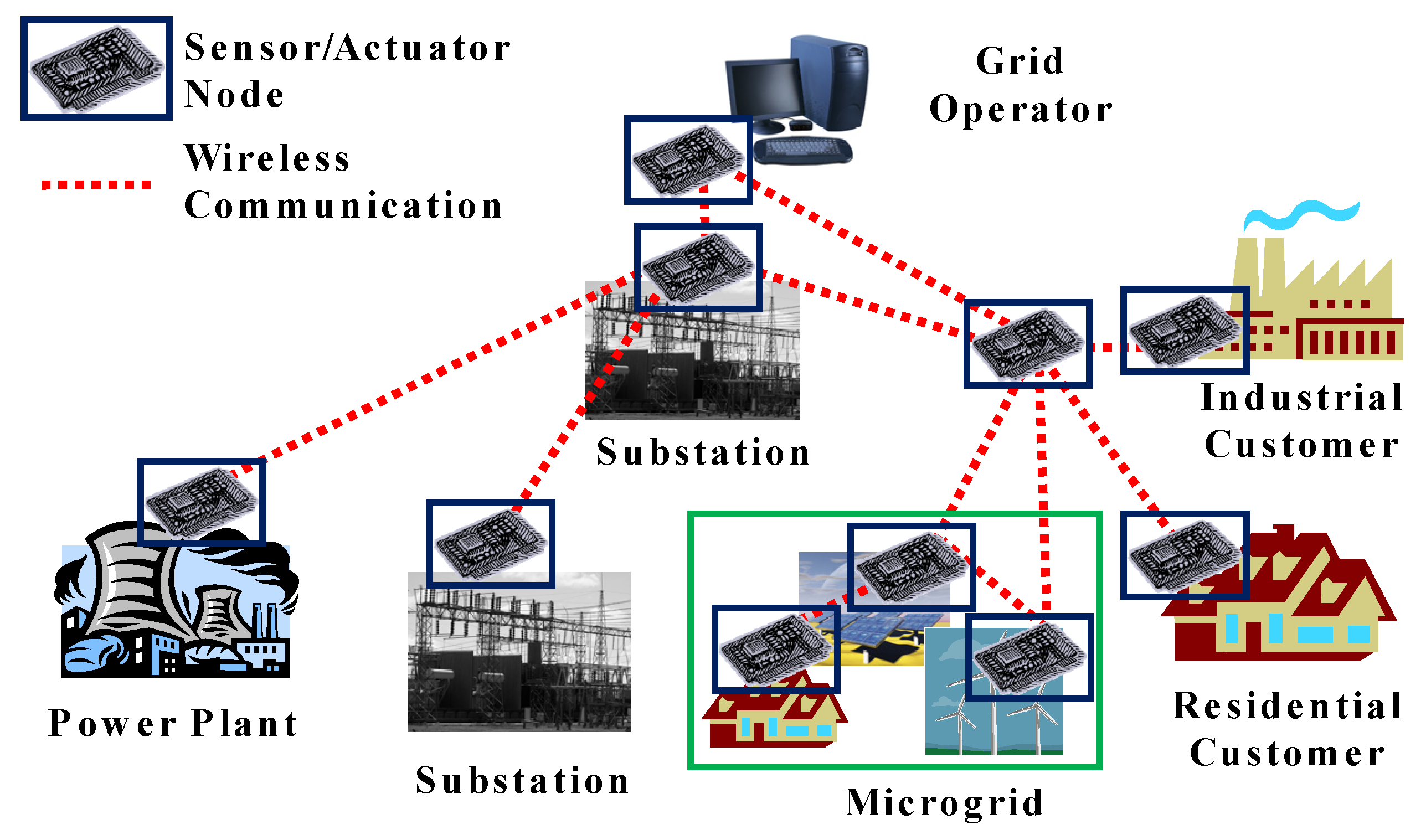
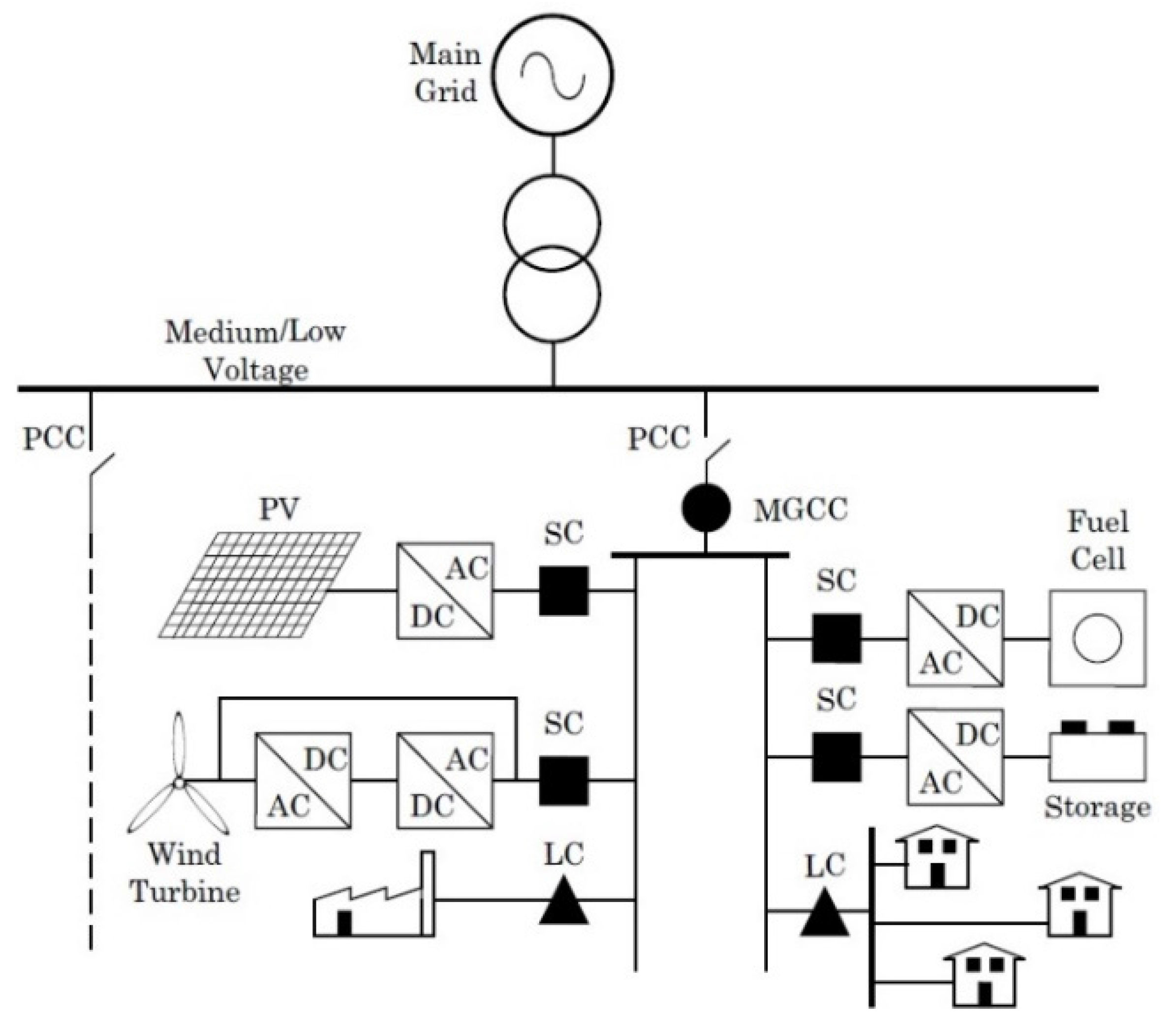
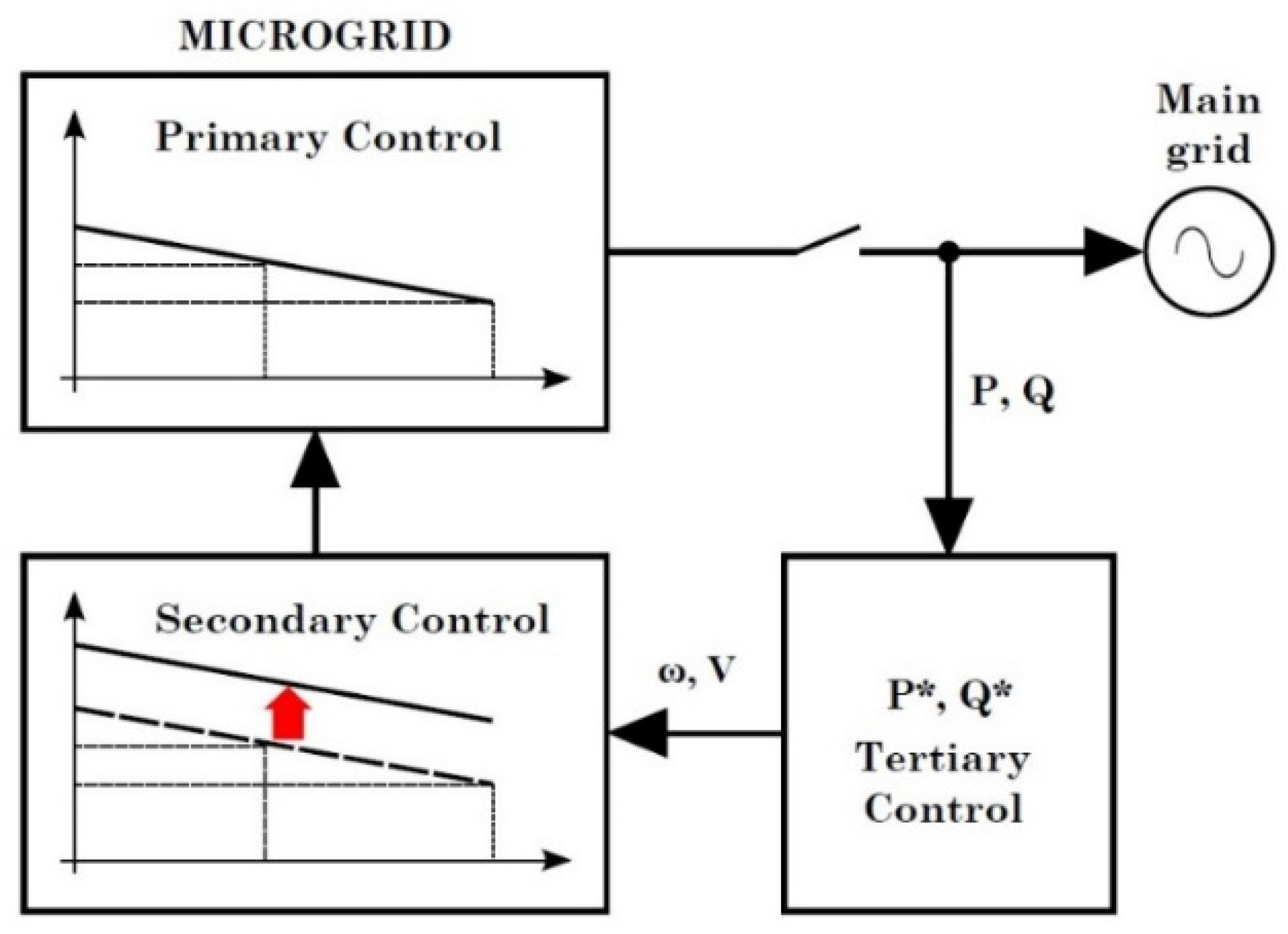
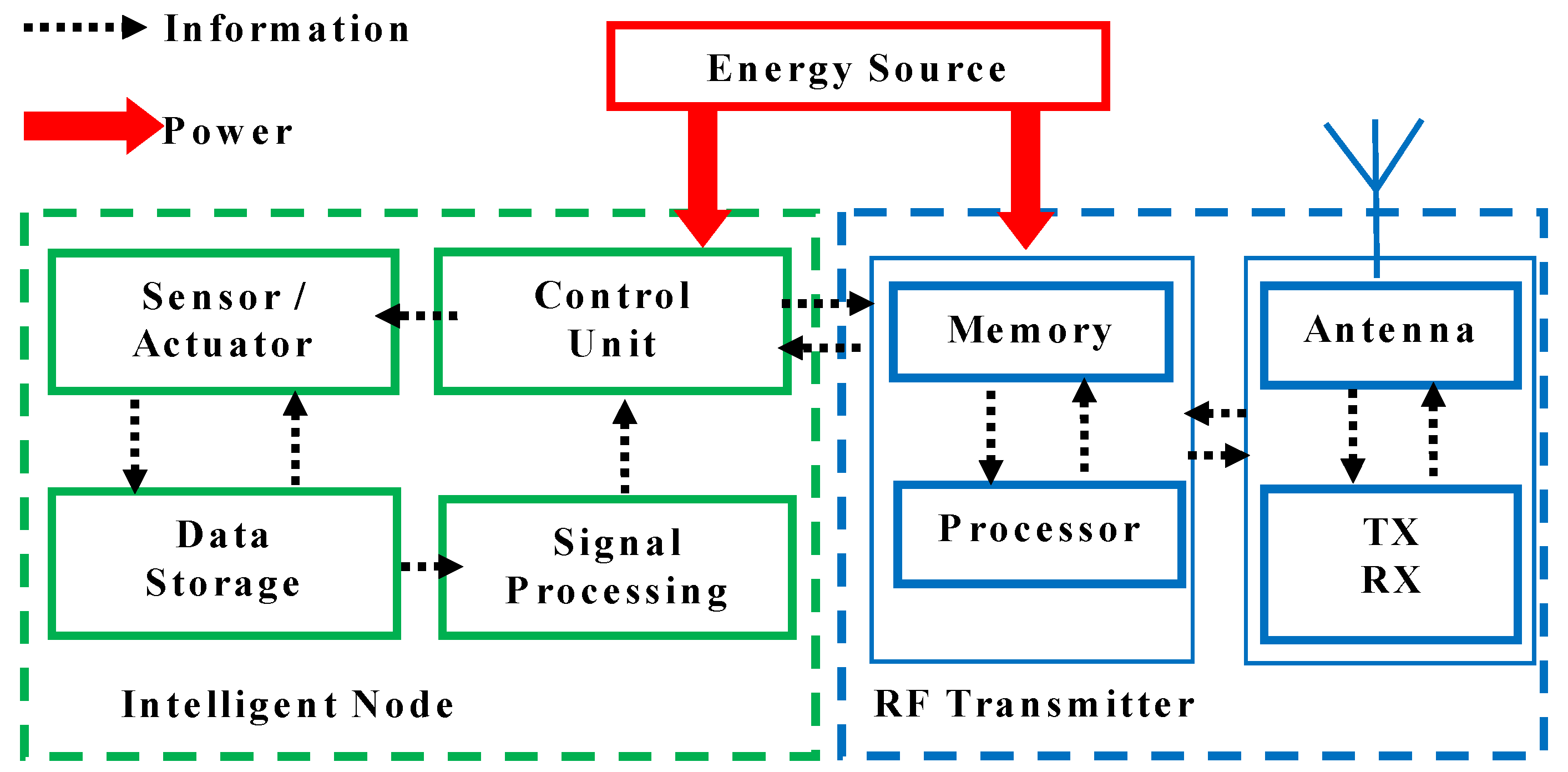
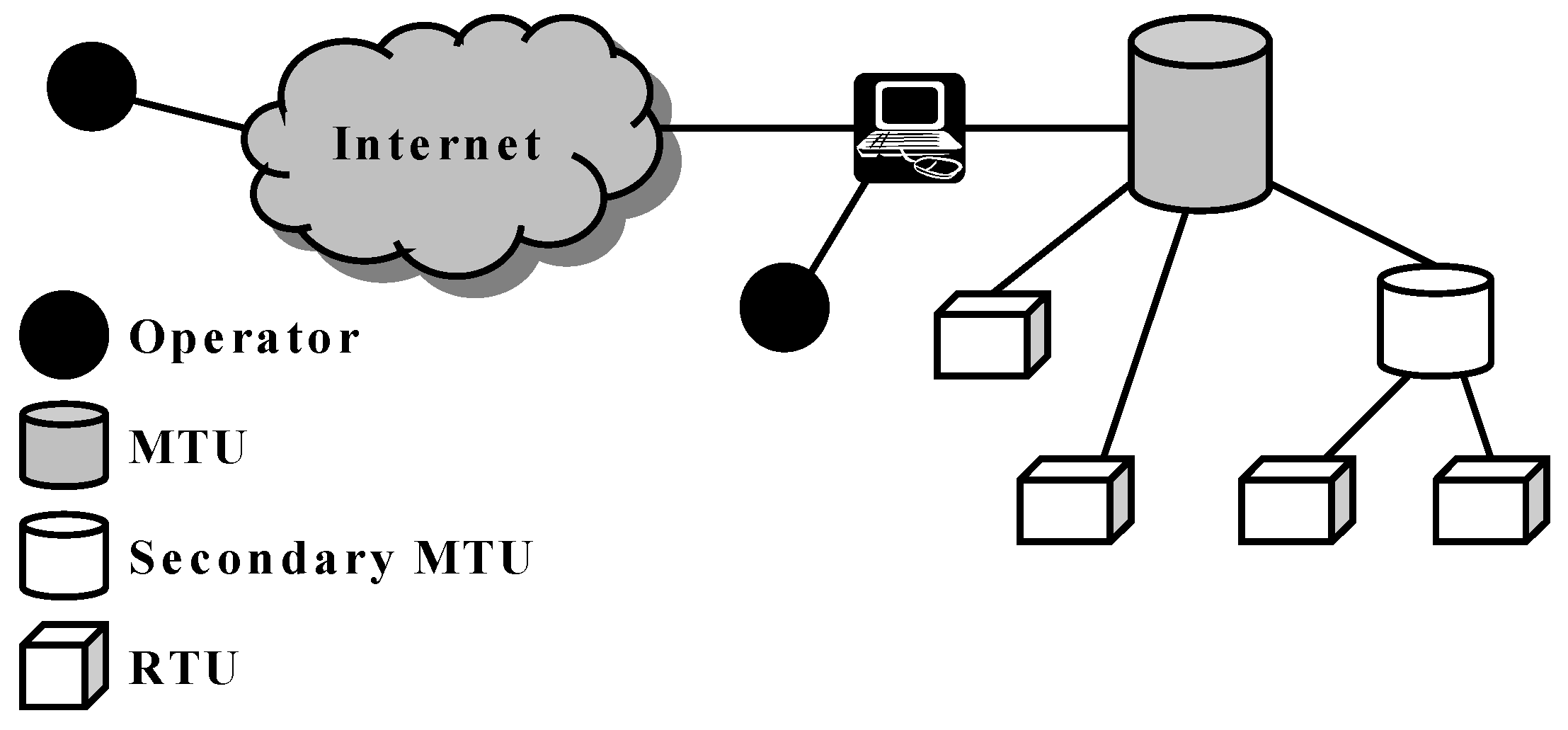
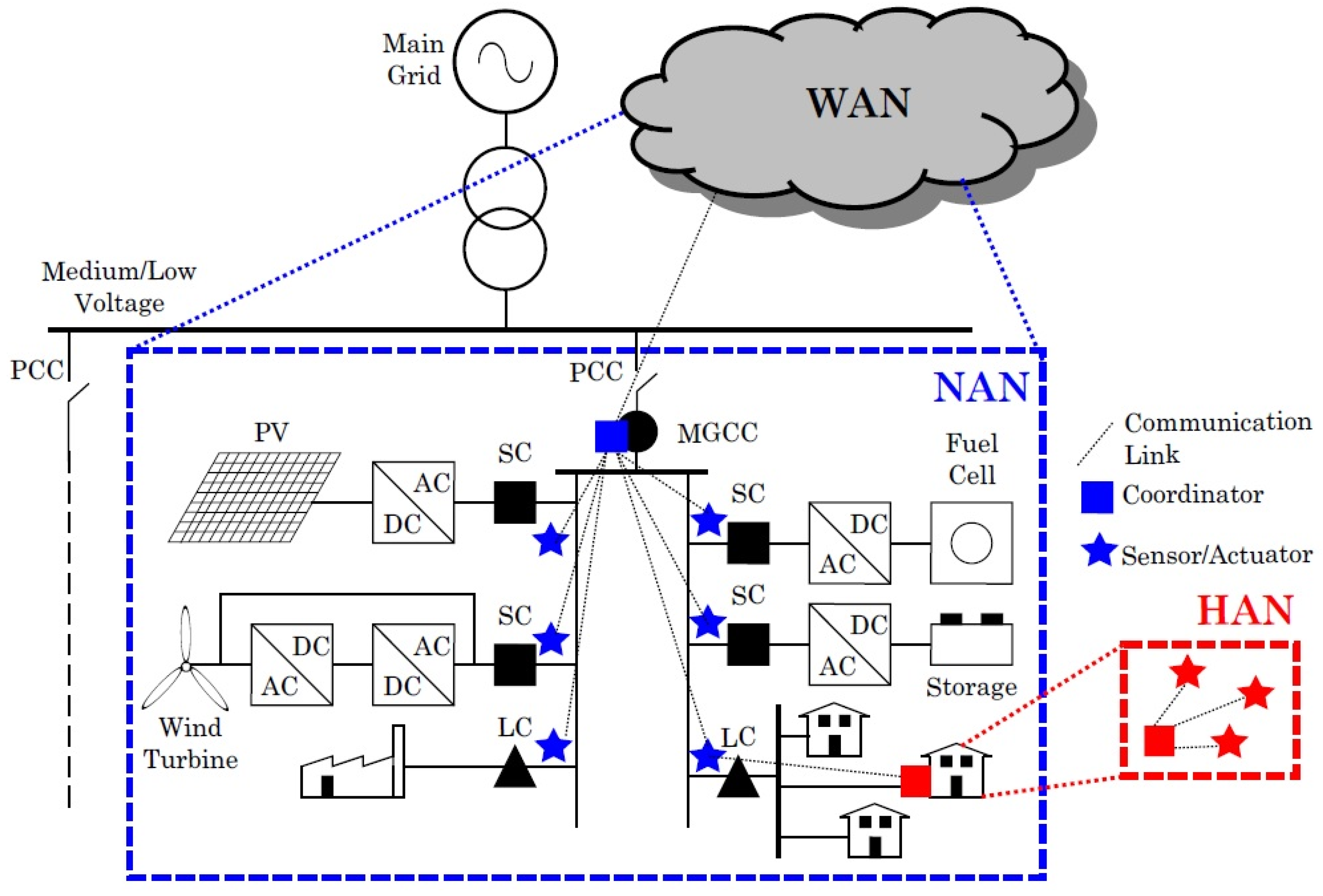
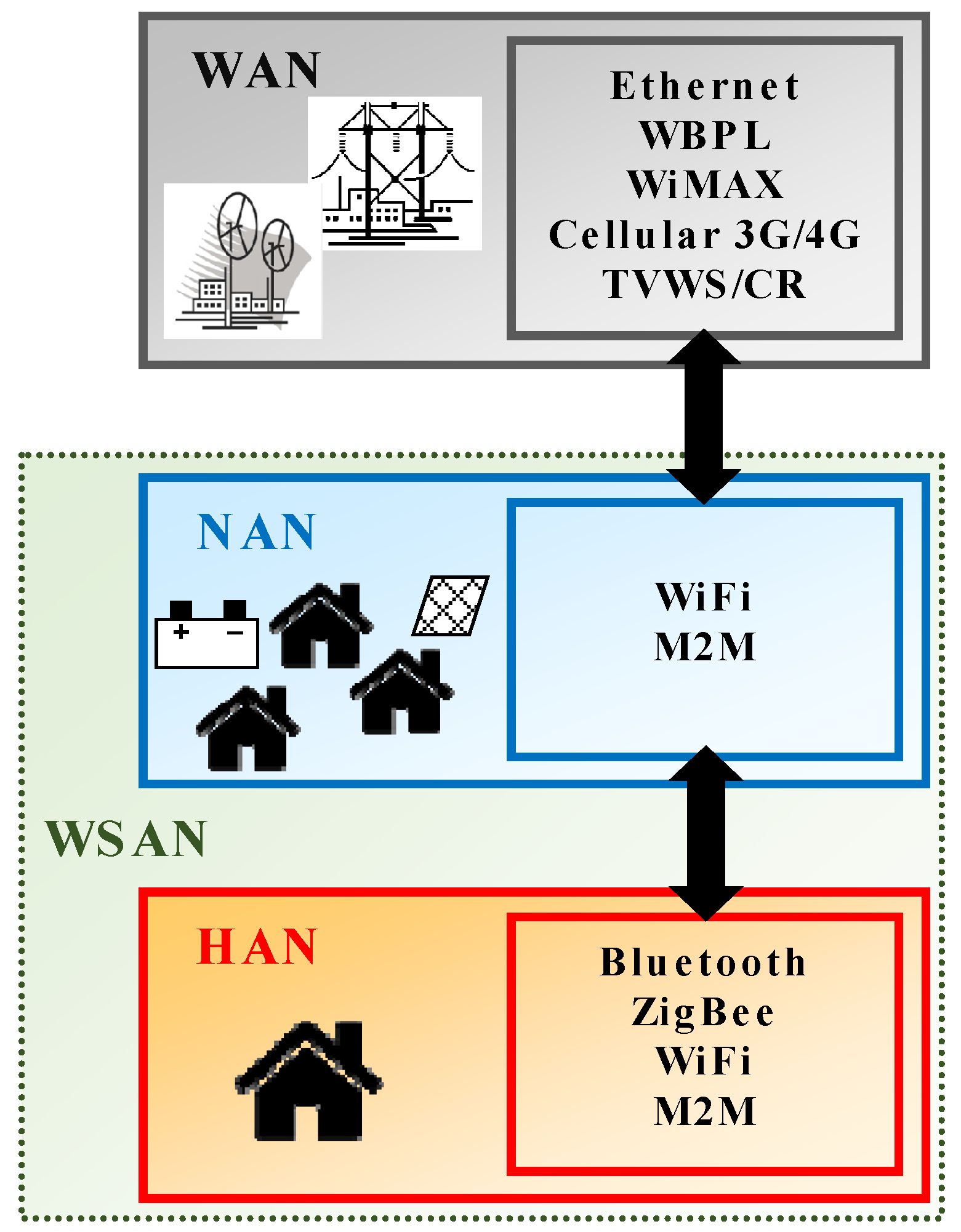
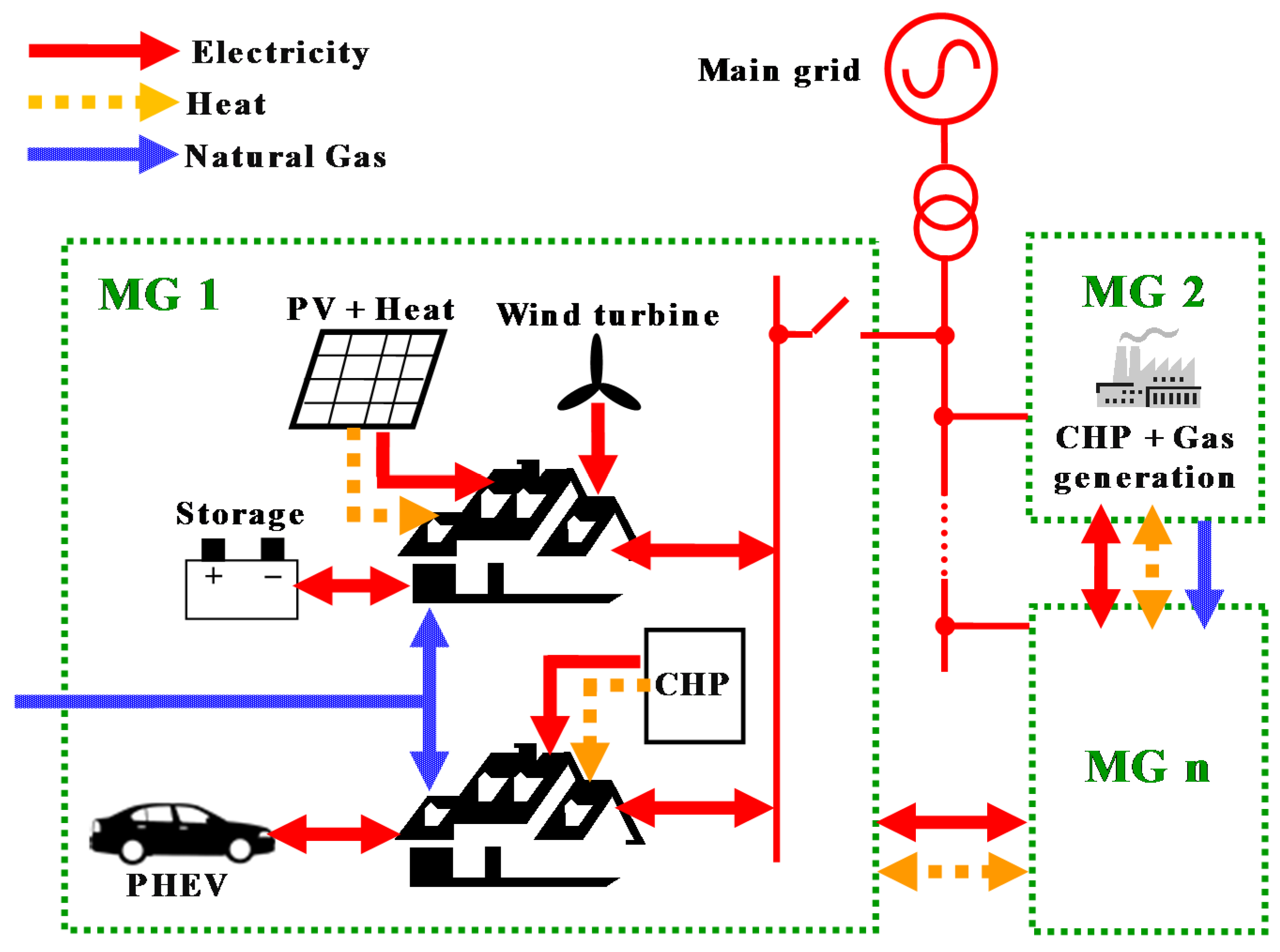
| Electrical Grid Segment | Application | Data Rate | Latency | Reliability |
|---|---|---|---|---|
| Generation | Traditional power plant monitoring | High | Low | High |
| Wind or solar farm monitoring | Medium | Low | High | |
| Transmission and distribution | Line or cable monitoring and fault detection | Low | Low | Very High |
| Distribution substation | Low | Low | Very High | |
| Outage detection | Low | Low | Very High | |
| Customer-side | WAMR | Low | High | Medium |
| iHEM/OREM | Low | Medium | Medium | |
| Distributed generation monitoring and control | Low | Medium | Medium |
| SG Network Level | Technology | Frequency Band | Data Rate | Range | Power Consumption |
|---|---|---|---|---|---|
| HAN | Bluetooth | 2.4 GHz | 720 kbps | 10 m | Classical: ≈100 mW Low-energy: ≈10 mW |
| ZigBee | 868 MHz/915 MHz 2.4 GHz | 250 kbps | 100 m | ≈10 mW | |
| HAN and NAN | WiFi | 2.4 GHz | Up to few Gbps | 200 m | ≈1.5 W |
| M2M solutions | ISM band | Up to 100 kbps | From 200 m to tens of km | ≈50 mW |
© 2016 by the authors; licensee MDPI, Basel, Switzerland. This article is an open access article distributed under the terms and conditions of the Creative Commons by Attribution (CC-BY) license (http://creativecommons.org/licenses/by/4.0/).
Share and Cite
Llaria, A.; Terrasson, G.; Curea, O.; Jiménez, J. Application of Wireless Sensor and Actuator Networks to Achieve Intelligent Microgrids: A Promising Approach towards a Global Smart Grid Deployment. Appl. Sci. 2016, 6, 61. https://doi.org/10.3390/app6030061
Llaria A, Terrasson G, Curea O, Jiménez J. Application of Wireless Sensor and Actuator Networks to Achieve Intelligent Microgrids: A Promising Approach towards a Global Smart Grid Deployment. Applied Sciences. 2016; 6(3):61. https://doi.org/10.3390/app6030061
Chicago/Turabian StyleLlaria, Alvaro, Guillaume Terrasson, Octavian Curea, and Jaime Jiménez. 2016. "Application of Wireless Sensor and Actuator Networks to Achieve Intelligent Microgrids: A Promising Approach towards a Global Smart Grid Deployment" Applied Sciences 6, no. 3: 61. https://doi.org/10.3390/app6030061





